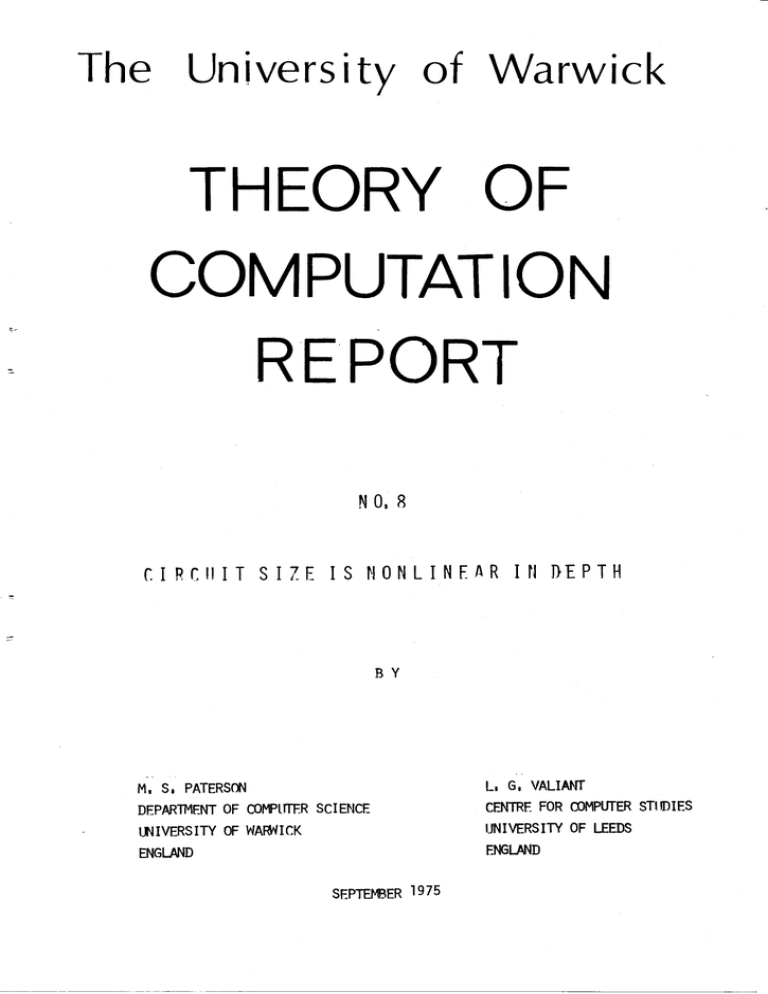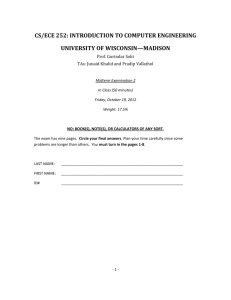THEORY COMPUTATION REPORT OF
advertisement

The University of Warwick
THEORY OF
COMPUTATION
REPORT
ll 0,8
CIRCIIIT SIZE IS NONLINEAR III
I}EPT|.|
BY
M. S,
PATERSCN
SCIENCE
LNIVERSITY oF WARI{ICK
ENGt-Al.lD
DEPARTIV1ENT
-
L, G, VALIAIIr
OF
COMPTTTER
gpp61,gpp'1975
CENTRF FOR CIMPI.JIER STIDIES
|JNI\ERSITY 0F
EtlGLAI,lD
LEEDS
C'ircuit Size is Nonlinear in
Depth
by
M.5.
Paterson
of Computer Science
unjversity of t^lanvjck
Department
Ab s
L.G. Valiant
Centre for Computer Studjes
university of
Leeds
tract.
Two fundamental complexity measures
for
a
f are its c'ircuit depth d(f) and
its circu"it size c(f). It is shown that c '. * d"1o9rd
for all f.
Boolean function
I"
lntroduction.
\^le
Boolean circuits for
consider acyclic
{o,lin * {Or1}} over the basis Br, Two complc>:ity
: {f I f :
Bn
measures, can
be defjned for f € B as follows
:
c(f) = minimum number of gates of a circuj-t to compute f,
cl(f) = minimum depth of a circuit to compute f'
where
the-:
depth of a circuit
is the
maxirnum number
of gates in
a
path 01' the circuit.
'l'hese measures satisfy the obvious relations
d
2 >c
>:
d:
and the example of n-argument conjunction demonstrates the
optimality of the first
the second to c ,. !, d. Iog.d as d
I{ccoff ancl Paterson [l]
for:.rll
f € Bn
In this paper we improve
inequality"
-+
-
have shown that d(f)
-<
n+I
If f depenrls on all its n arguments then cl-early
c(f)>n_landthereforeourresultcanbeusefulforon1yasma]l
r;rn1,,e ol complexitieL;. However, we hope that ihe novel construction
inl r<r,lttccrl in thc llro<:I wi-l-l- tre oi' interes;1 '
?-. Preliminaries.
hlith any circuit Z, a <lirected acyclic graph can be associated
in the usltal way.
Itrocles
of the graptr correspond either to inputs
or. to log,ica1. gates. Let e(z) be the nrrmber of arcs;oining pairs
of g.ate nodes in the graptr of
Z
.
We
define
l:(.2) -- max {cl(f ) | f ls computed by a circuit
witlr e Q) s z,\
,
Z
2
and
A(
d) : n.rx 1..:r | ::{z ) .' d}
i- z.';
,
L'olr
c.Lr
i,r,rr,i,
i'r.r'
.11r.,,
l,enm.l
O3
l-r
{z:) '< I + D(z-1).
. rr:,uij: Z with e(Z) = z > Or consider one of its gates
th;rL tras orrlr; ii.rp'i.i: i.arj.ables; as inputs, and replace this gate by a
new
iic resulting new function is computed by a circuit
Za
inprrt var.iai;lr:.
with e(Z-j ) s
'l
z-'-'; aricl so iras depth
at most D(z-l).
It follows that
D(z) -< I + ]li.z. , i :,.:,frce tlle original function requires a depth of at
i
rnost one rlot'i:
3.
i
Main rc,:;,.it"
Theorem" I'or
,r.1
I i-,,,liean functions,
,'-,log^d - o(d)
. ,:,'_.:
i)r-oof
,
i;-itl)it.,i.,.r
', .:, ci c;rcrrit of
minimum
Size computing a function f
iii r :tr-,t.rt,ose e(Z) = z > C. We consider partitions of the
'.1^,
gates'Jf ii r.rir., ,,';rr;; )' ai:il Y such that no gate of Y precedes a gate of X"
.rt gate
lf Y is
non- cnp.tI,) ;i.er, i:.,
f Y, Let
M
C X be the set of gates of X adjacent
.rili .lr:'i in . lMl" We denote by X the circuit with X as the
:;et r-r1' !!,i1-r?ij. .ii;,i t,rritrj i1lt11 inputs as in Z . We denote by -I the circuit
to gates oi
'r'
with Y as r,iL,,'1,;l 'f gates, with the inputs of Z together with new inputs
cor\rle:jp,rr],iil; t ) ,t.,-.i: rir:cle of M as its set of inputs and arcs as in Z.
If e(,{) = x .rriii r,ii'i . y then we have
Xi-'.{+m\<Z
:;ince each nor]e of'14,iccr)unts for at least one arc frOm X to Y.
(r)
3
We
1'he
wish to select a partition so that x and y are nearly eqrral.
tr.rnslerence of one gate from X to Y reduces x by at most Lwo
and m
by at most one, therefore we may choose a partition such that
izx + m - zl s
z
Q)
If we define v = max {*, y}, then fnom (I) and (z) we deduce that
Since X is a circuit
(3)
2
2v+m<z+
for each of the functions computed at
nodes of M, each of these may be computed in depth D(x), by the
definition of D. By composing these ci::cuits with a minimal depth
ninnrrit acrliva'lent to -I we can construct a circuit for f which
L
vaur
r\^Jv
estabL-ishes
(4)
d(f) -< D(x) + D(y).< 2D(v)
An alternative circuit
for f is designed as follows.
Fon
each vector c€ {Or]}m, r'eplace each noCe of M (under some fixed
ordering) in
-Y
by the corresponding constant in c and simplify
Y
by absorbing these constants into the gates. Let Y.J be the
r^-.,r
.-.'-^,,i
.- -g
f
! c- ur F;-^
L rl1t5
u r! ,-*' 1
* and
---
the function it computes at g^.
Thus
's'
d(t ) < D(y). For each c, fet 6 be the function which is I if
s
arrd onlv if the nodes of M inX have the values corresponding to
'fher;r: are just cor:junctions of 1he (possibly negated) functions
compute(j by
x at the
m nodes
of
M
and so require depth at most
D(x) + [iog rn1. Using the identitY
f = V6
-cc rf
we may prrcduce a circuit
d(f)
for: f establishing
.< max{D(x)
+ lrog ml, n(y)] + r t
sincc the djsjunction requires just
m
parallel steps.
m
co
ll
llt)'l
\:-rz +3+flogml
Irr
i.,',
c)r.
1.ii
irr
7,"
f and Z were chosen for
"/'
: !\\
r so that
.'
, i'. I or, equivalently,
'
Rv f i,,.
..
',:
. iii-i'
:
and ii'v:
some
"
i ti
'I'lti'i,
(5)
.:,gualities for d(f ) each defined in terms
i-,r" r ' ,,,f
"
from(3)
;-i
A(LT /2
))
(6)
,le of (S) is a decreasing function of v,
-r(:i'efore it
r.
v)
may be bounded above
by taking
AlI
i'
'. i,t'i2J)
+ 1) + z-F 3 r ltog
z1
OI'
z i-i.:..'
ri
rri
I i..:
1\(
i'i
i'/zl - z
.,.i
(7)
i.eclirrence inequality for the frrnction
:
+ 2fog.r
kr
- Jr. Iog,,r
I -t
i.i,i:,. Ji;t,.''
'2>
ior. ,rli ri
'-'1r
t
rr,
r.
H(r) + l + [Iog(H(r) + ])l
..,:,:irtiY large rr we can pnove by induction
r
= *r.Logrr - 0(r)
L'oi',
,.rn\.,
i so we have pfoved
,
:
,'c1 -0(d)
n
Corollary l"
For all functions f
d
Corollary 2.
-<
O(s/Iog c)
l'or any sequence of functions fr, f3r"'
where
f nn€ B with linear circuit complexity, that is c(f-) = 0(n)'
there is a constant A such that for afl no f- can be represented
n
bv a formula of size on/log .
Reference
Ir]
w,F. McColl and M.s" Paterson, "Depth of atl Boolean functions",
TheoryofComputationReportT'UniversityofWarwickI9T5.






